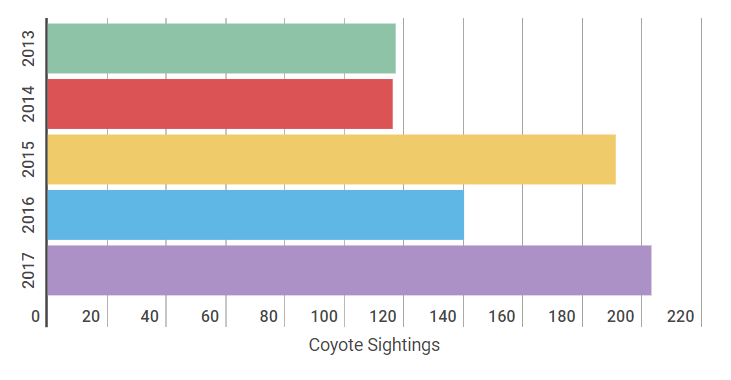With last year’s late spring creating a delay in the snow melting, many rural critters were forced to venture closer to developed areas in their search for food. By last spring, just 6 months into 2017, Ottawa’s Bylaw Division had received more complaints and sightings of coyotes than compared to all complaints filed during 2016. But what exactly are we seeing? Ottawa Bylaw states that many individuals are seeing “Coywolves”, a common hybrid of the Coyote and Grey Wolf. Coywolves often cause alarm when they are seen as they can be double the size of a regular coyote which usually peaks at 40 lbs. While Coywolves are generally larger in size, they tend to be no more aggressive than a regular coyote however it is important to keep in mind that they are still a wild animal.
Here is a chart that shows the number of Coyote sightings over the years:

Image from http://www.davidmckie.com/coyote-sightings-hit-new-high-in-ottawa/
On the evening of January 30th, one of our very own team members had a neighbor in McKellar Park witness a coyote leisurely walking through his backyard. While the presence of coyotes is alarming, it acts as a reminder that we share our neighborhoods with critters both big and small as we build and encroach upon their territories.
Below we’ve compiled a few of our top tips for increasing your safety and awareness should you encounter a furry visitor in your Ottawa neighborhood.
Remain Vigilant: If you experience or hear of a coyote sighting within your neighborhood, ensure that you and your family remain vigilant when leaving your home. This should be practiced during both daytime and nighttime hours.
Supervise Pets & Young Children When Outside: If you’re letting your child or pet outside into the yard, keep a close eye on them to keep them safe and make sure that all food is kept inside so that you don’t potentially attract an animal. Make noise before venturing out to scare any wild animals before entering your yard. and it may also be a good idea to do a quick sweep to ensure that no animals are hiding out of sight.
Make Noise: Creating a startling noise such as clapping your hands, stomping your feet or saying a few words loudly will help to frighten off coyotes. For coyotes who have acclimatized to urban living, they may have become comfortable with the surroundings that you’ve provided outside of your home. Noise will help to show them that they are not welcome on your property and may deter them. It is important to note that if you have a persistent coyote in your neighborhood, refrain from doing anything which may harm the animal as it may accidentally harm a neighborhood pet. Instead, visit Ontario.ca/livingwithwildlife for more information about coyotes and how to interact with them.
Reduce Hiding Spaces & Food Sources: Coyotes and hybrids tend to like secluded areas and enjoy hiding out in areas filled with brush. Take a walk around your property or home and ensure all areas of brush or undergrowth is cleared to minimize potential hiding places. Make sure that all fruit-bearing trees are well maintained and that fallen fruit is cleaned up before snowfall. While coyotes are omnivores and will eat fruit should the situation arise, the more pressing reason to clean up after fruit-bearing trees is due to the small animals attracted.
Keep Your Distance: At the end of the day, we all share our neighborhoods with wildlife of all sizes. While they may look harmless, it is important to give these animals their space and never attempt to approach a coyote.
To tell us about your experience with neighborhood coyotes, leave us a comment below or email us here.

